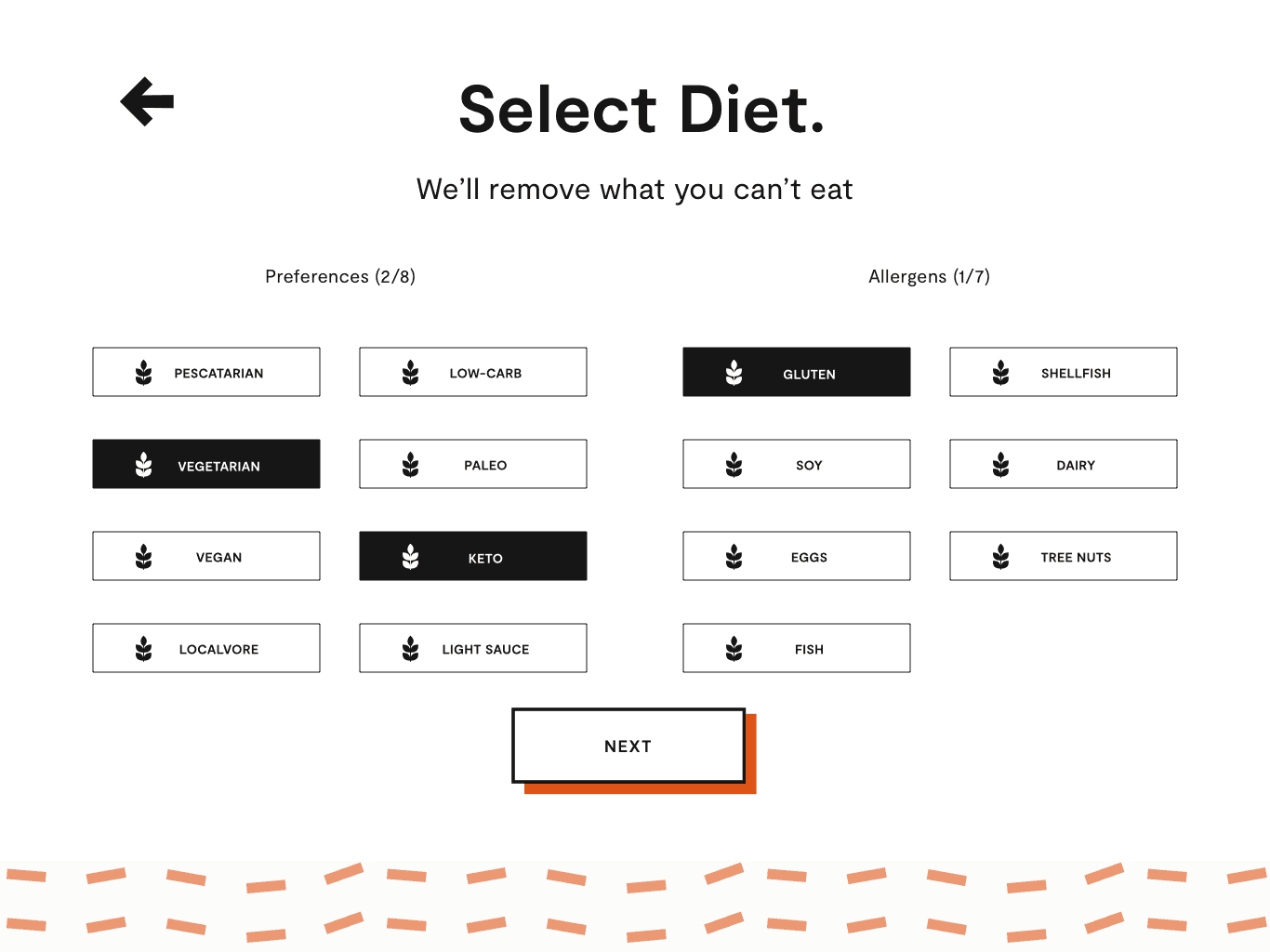Spyce hired me to revamp their kiosk ordering app – coinciding with the opening of their second, larger restaurant
I worked with the team to ideate a number of options.
After creating wireframe concepts, I developed figma prototypes to present various ordering app approaches. These concepts were tested with users using Lookback, and feedback was used to refine the designs.
Enter your number or scan QR to remember your dietary requirements
Add more dietary restrictions to onboarding
Adding allergy selector to ordering screen
Working with Red Antler designed branding, I adapted Spyce's marketing-based visual language to suit touchscreen interfaces. Multiple iterations were made to Red Antler's style guide, aligning elements with the mobile and tablet experience. Accessibility was also improved.
Design Considerations for Touch Screen POS
Minimize recall: Users should be reminded of items they're customizing, the customizations themselves, and previous orders.
Accessibility for all: Ensure that users with diverse backgrounds, abilities, and conditions can easily complete their orders.
No frills: Design the touchscreen with simplicity in mind, avoiding unnecessary visual elements and steps.
Efficiency: Minimize clicks while providing users with back buttons to rectify errors.
Privacy: Limit the sharing of personal information for confident transactions.
Targets: Make touch targets large enough for users with large hands.
Consider UI for different lighting conditions.
Offer clear and concise copy.
The revamped Spyce touchscreen ordering kiosk app has led to a significantly improved user experience. Through careful design considerations and extensive usability testing, the following results were achieved:
Reduced Friction: The streamlined user interface and optimized user flows have significantly reduced the time it takes for all customers to place their orders. This has led to a smoother and more efficient ordering process, benefiting both the users and Spyce.
Enhanced Accessibility: The implementation of accessibility features ensures that users of all backgrounds and abilities can easily navigate the application. This has created a more inclusive and user-friendly experience.
Improved Confidence: Customers with dietary preferences and restrictions now feel more confident when placing their orders, thanks to a more intuitive and accommodating interface. The redesign addressed their specific needs and concerns.
The successful integration of Red Antler's branding into the touchscreen app has further solidified Spyce's visual identity and helped emphasize the human touch in their branding. This alignment with the broader branding initiative has reinforced the following aspects:
Brand Consistency: The kiosk app now maintains consistency with the broader brand, creating a cohesive brand experience across all customer touchpoints.
Emphasizing Humanity: The design and branding work collectively emphasize Spyce's transition from "the robot restaurant" to a brand that values and prioritizes the human element in hospitality.
Upon the release of the updated app, Spyce received positive feedback from users, with many expressing their satisfaction with the improved interface and the ease of use. This positive feedback is a testament to the project's success in meeting user needs and expectations.
In conclusion, the UX redesign of Spyce's touchscreen ordering kiosk app has successfully achieved its objectives by enhancing the user experience, integrating branding seamlessly, and receiving positive user feedback. The project sets the stage for Spyce to continue its journey as a pioneer in the culinary industry, offering a unique and user-centric dining experience.
In-Depth Dietary Surveys: I'd recommend to conduct in-depth surveys and interviews with users to gather more detailed information about their specific dietary preferences, restrictions, and expectations. This will help Spyce better understand individual needs and tailor the menu offerings accordingly.
Integration of AI and Personalization: Explore the integration of artificial intelligence (AI) to offer personalized diet-informed recommendations. AI algorithms can consider users' dietary profiles and recommend suitable menu items, making the ordering process even more user-centric.











